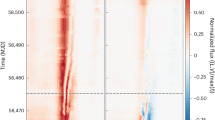Abstract
OBSERVATIONS of the abundances of elements provide insight into their production and distribution. The production of light elements (in particular, lithium, beryllium and boron) is dominated by spallation reactions1, in which cosmic rays break apart more massive nuclei. Models2,3 suggest that the 11B/10B ratio should be about 2.5, but the observed ratio in the Solar System is about 4 (refs 4,5). This has led to the suggestion5 that the pre-solar nebula was subjected to bombardment by low-energy Galactic cosmic rays, leading to an overproduction of 11B (ref. 6). Until now, it has not been possible to measure the 11B/10B ratio in the interstellar medium, because the lines are very weak. Here we present a spectroscopic measurement of the 11B/10B ratio in the interstellar gas lying between the Earth and the star δ Scorpii, made using the Hubble Space Telescope. Our measured ratio, 3.4+1.3−0.6, is comparable to the meteoritic value5, but somewhat lower. Further measurements will be needed to establish whether the ratio reported here is characteristic of the interstellar medium in general.
This is a preview of subscription content, access via your institution
Access options
Subscribe to this journal
Receive 51 print issues and online access
$199.00 per year
only $3.90 per issue
Buy this article
- Purchase on Springer Link
- Instant access to full article PDF
Prices may be subject to local taxes which are calculated during checkout
Similar content being viewed by others
References
Reeves, H., Fowler, W. A. & Hoyle, F. Nature 226, 727–729 (1970).
Meneguzzi, M., Audouze, J. & Reeves, H. Astr. Astrophys. 15, 337–359 (1971).
Reeves, H. A. Rev. Astr. Astrophys. 12, 437–469 (1974).
Anders, E. & Grevesse, N. Geochim. cosmochim. Acta 53, 197–214 (1989).
Chaussidon, M. & Robert, F. Nature 374, 337–339 (1995).
Meneguzzi, M. & Reeves, H. Astr. Astrophys. 40, 99–110 (1975).
Diplas, A. & Savage, B. D. Astrophys. J. Suppl. 93, 211–228 (1994).
Savage, B. D., Bohlin, R. C., Drake, J. F. & Budich, W. Astrophys. J. 216, 291–307 (1977).
Cardelli, J. A. & Ebbets, D. C. in Calibrating Hubble Space Telescope (eds Blades, J. C. and Osmer, S. J.) 322–331 (Space Telescope Science Inst, Baltimore, 1994).
Brandt, J. C. et al. Publs. astr. Soc. Pacif. 106, 890–908 (1994).
Jönsson, P., Johansson, S. G. & Froese Fischer, C. Astrophys. J. 429, L45–L48 (1994).
Hobbs, L. M. Astrophys. J. 191, 381–393 (1974).
Cardelli, J. A., Savage, B. D. & Ebbets, D. C. Astrophys. J. 383, L23–L27 (1991).
Savage, B. D. & Sembach, K. R. Astrophys. J. 379, 245–259 (1991).
Lambert, D. L., Sheffer, Y., Gilliland, R. L. & Federman, S. R. Astrophys. J. 420, 756–771 (1994).
Meneguzzi, M. & York, D. G. Astrophys. J. 235, L111–L114 (1980).
Federman, S. R., Sheffer, Y., Lambert, D. L. & Gilliland, R. L. Astrophys. J. 413, L51–L54 (1993).
Jura, M., Meyer, D. M., Hawkins, I. & Cardelli, J. A. Astrophys. J. 456, 598–601 (1996).
Boesgaard, A. M. & Heacox, W. D. Astrophys. J. 226, 888–896 (1978).
Lemke, M., Lambert, D. L. & Edvardsson, B. Publs. astr. Soc. Pacif. 105, 468–473 (1993).
Kohl, J. L., Parkinson, W. H. & Withbroe, G. L. Astrophys. J. 212, L101–L104 (1977).
Learner, R. C. M. & Harris, C. J. Astrophys. J. 320, 926–927 (1987).
Zhai, M. & Shaw, D. M. Meteoritics 29, 607–615 (1994).
Bloemen, H. et al. Astr. Astrophys. 281, L5–L8 (1994).
Cassé, M., Lehoucq, R. & Vangioni-Flam, E. Nature 373, 318–319 (1995).
Reeves, H. & Prantzos, N. in Light Element Abundances (ed. Crane, P.) 382–388 (Springer, Berlin, 1995).
Ramaty, R., Kozlovsky, B. & Lingenfelter, R. E. Astrophys. J. 456, 525–540 (1996).
Vangioni-Flam, E., Cassé, M., Fields, B. D. & Olive, K. A. Astrophys. J. (in the press).
Gibner, P. S., Mewaldt, R. A., Schindler, S. M., Stone, E. C. & Webber, W. R. Astrophys. J. 391, L89–L92 (1992).
Beckman, J. E. & Casuso, E. in Light Element Abundances (ed. Crane, P.) 105–117 (Springer, Berlin, 1995).
Johansson, S. G., Litzén, U., Kasten, J. & Kock, M. Astrophys, J. 403, L25–L28 (1993).
Morton, D. C. Astrophys. J. Suppl. 77, 119–202 (1991).
Author information
Authors and Affiliations
Rights and permissions
About this article
Cite this article
Federman, S., Lambert, D., Cardelli, J. et al. The boron isotope ratio in the interstellar medium. Nature 381, 764–766 (1996). https://doi.org/10.1038/381764a0
Received:
Accepted:
Issue Date:
DOI: https://doi.org/10.1038/381764a0
This article is cited by
-
First Evidence on the Role of Heavy Ion Irradiation of Meteorites and Formamide in the Origin of Biomolecules
Origins of Life and Evolution of Biospheres (2016)
-
Newly synthesized lithium in the interstellar medium
Nature (2000)
Comments
By submitting a comment you agree to abide by our Terms and Community Guidelines. If you find something abusive or that does not comply with our terms or guidelines please flag it as inappropriate.



